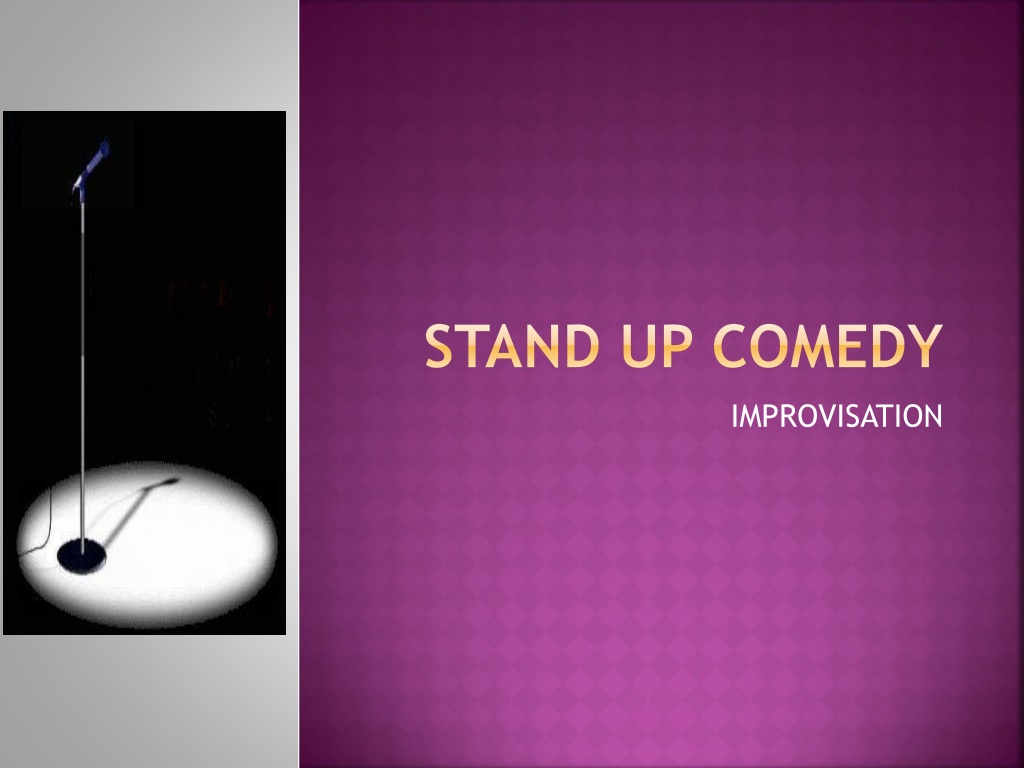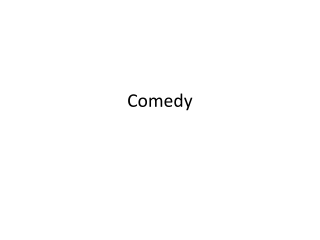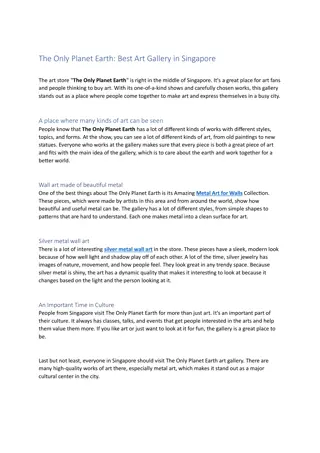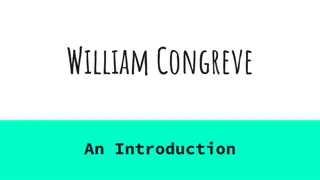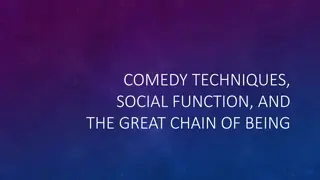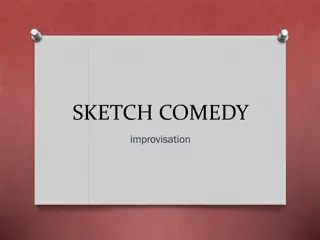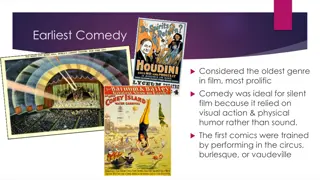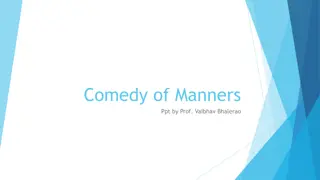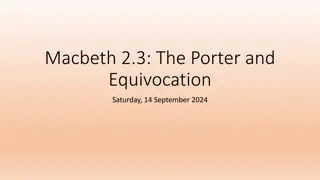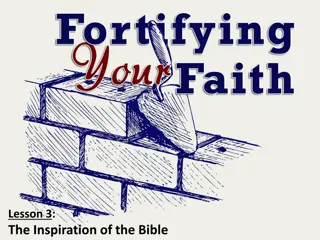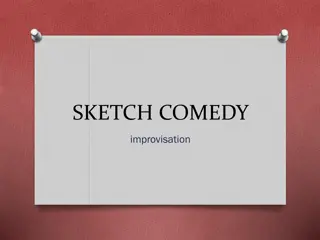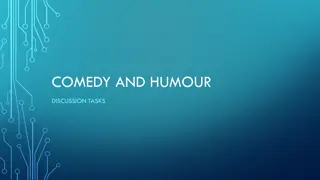Mastering the Art of Stand-Up Comedy: Techniques and Inspiration
Explore the world of stand-up comedy with a focus on improvisational techniques, creating original routines, essential comedy vocab, and steps to writing stand-up material. Dive into studying different types of comics and their approaches, from observational to topical, character-based, and prop comedy. Unleash your creativity and humor as you embark on a journey to craft your unique comedic voice.
Download Presentation

Please find below an Image/Link to download the presentation.
The content on the website is provided AS IS for your information and personal use only. It may not be sold, licensed, or shared on other websites without obtaining consent from the author. Download presentation by click this link. If you encounter any issues during the download, it is possible that the publisher has removed the file from their server.
E N D
Presentation Transcript
STAND UP COMEDY IMPROVISATION
ESSENTIAL QUESTIONS In what ways are improvisational techniques used to create Stand-up Comedy? What paths can one take to create an original Stand-up Comedy routine?
COMEDY VOCAB SET Your collection of jokes. A noun. (E.g., "I just memorized my set.") TO KILL To do really well. The audience loves you. SETUP The explanation part of a joke. It's the part of the joke that you're not supposed to laugh at. The exposition of a situation or story. TO BOMB To do really badly. This is where there is a danger of tomato peltage. DYING The process of bombing. PUNCH LINE The funny part of a joke. What you're supposed to laugh at. HECKLER Someone in the audience who talks and interrupts a comedian in an insulting way, in attempt to make the comedian bomb. BLUE When a comic is "blue," it means that he/she is using dirty language and/or talking about adult situations in an explicit way.
STEPS TO WRITING STANDUP STEP 1 Study the pros STEP 2 Gather material STEP 3 Write the routine STEP 4 Rehearse the routine
STEP 1: STUDY THE PROS OBSERVATIONAL COMIC The observational comic picks up on all the quirks and minute details of everyday life. Most common Topics ex: dating, airline travel, dogs vs. cats, the differences between men and women Jerry Seinfeld https://youtu.be/udSueYXIkkA Cab drivers 6:15 Airports 7:57 Halloween 16:30-22:40 Grocery stores 22:44 No.1 fear 50:25 Sky diving/helmet 51:10 Bathrooms 1:04:10 Ellen Degeneres http://youtu.be/BB9Kf9BCcKk
STEP 1: STUDY THE PROS TOPICAL COMIC Topical comedy relies on headlining/important news and current affairs. It dates quickly, but is a popular form of comedy for late night talk shows. Stephen Colbert https://youtu.be/IDQ0f4n 9aAo David Letterman, Jimmy Fallon, Bill Maher, Tosh
STEP 1: STUDY THE PROS CHARACTER COMIC Character comedy derives humor from a persona invented by a performer. Tim Allen (macho man) https://youtu.be/30K2hhnV88I (stop at 4:35) Larry the Cable Guy (white collar worker) https://www.youtube.com/watch? v=5hX28XIIhSQ&index=3&list=PLecI f_z8bVyTXob9Jtk2kXUV109pFsZbV (4:00-5:45) Much character comedy comes from stereotypes Sarah Silverman (feminist) Margaret Cho (Asian) http://youtu.be/HpqjErGfJ9c Gabriel Iglesias (Mexican/overweight) http://youtu.be/5QQzusr4IH0
STEP 1: STUDY THE PROS PROP COMIC Comedy that relies on ridiculous props, casual jackets or everyday objects used in humorous ways. Carrot Top http://youtu.be/hOQ8FYz_AJI Gallagher http://youtu.be/gasAFyonmmI
STEP 1: STUDY THE PROS PHYSICAL COMIC Somewhat similar to slapstick, this form of comedy uses physical movement and gestures Jim Carrey http://youtu.be/3pulxxEkoYY Dane Cook http://youtu.be/_LcsZ5DDS7U (clean)
STEP 1: STUDY THE PROS Dana Carvey (George W. Bush, Johnny Carson, Jimmy Carter, Bill Clinton, Bill Cosby, Jay Leno, Richard Nixon, Ross Perot, Arnold Schwarzenegger, Donald Trump) http://youtu.be/uAO4YHBpPyU IMPRERSONATION COMIC When the comic imitates the appearance, voice or manner of a well-known celebrity Frank Caliendo (Jerry Seinfeld, Robert De Niro, Casey Casum, John Maden) http://youtu.be/kAMIlPudalQ
STEP 1: STUDY THE PROS IMPROVISATIONAL COMIC Improvisational comics rarely plan out their routines. Robin Williams https://youtu.be/cVF6S-BDM6k Set List: Stand-Up with out a Net use your imagination not your material http://youtu.be/ZGVA-tDyj1o Wayne Brady, Ryan Stiles, Colin Mochrie Drew Carey
STEP 2: GATHER MATERIAL YOUR GREATEST RESOURCE IS YOURSELF. 1. WAF TRAITS (worry, angry, frighten) 2. NEGATIVE TRAITS 3. UNIQUE TRAITS Examine your own experiences. Look at your eccentricities Focus on your point of view Humor is PERSONAL!! Write EVERYTHING down. Even the dumb things. Sometimes bad ideas can lead to good ones.
STEP 3: WRITE THE ROUTINE WRITING JOKES Most jokes are based on the setup and punch line formula. First, the setup explains what the joke is about and then the punchline delivers the laugh Setup - "My mother is so fat..." Punch line - "...her booty has its own zip code."
STEP 3: WRITE THE ROUTINE PUNCHLINES What makes a joke funny is CONFLICT. Set up an expectation and violate that expectation. Groucho Marx: One morning I shot an elephant in my pajamas. How he got in my pajamas, I don t know. 1/2 way through the joke, Marx is wearing the pajamas, then the expectation changes This is the formula for a punchline. Lucile Ball: Every since we said I do, there is so many things we don t!
STEP 3: WRITE THE ROUTINE The average audience's attention span is very short, so they're not going to be able to follow a long setup without losing interest. They want to be easily entertained. Thinking is hard, laughing is easy. Don't give them too much to think about. I had a wonderful evening, but this wasn t it - Groucho Marx
STEP 3: WRITE THE ROUTINE Lists The magic number in comedy is 3. The first two are alike, but the third is the opposite. Comparisons Pointing out vast differences. "My girlfriend's idea of a romantic night is a candle lit dinner and a walk on the beach. Mine is a six- pack and a bag of Fritos."
STEP 3: WRITE THE ROUTINE Simile Describing something by showing how it is like the other "He looked like a squid in stretch pants." Observations Pointing out how absurd everyday life is. "You can't have everything. I mean, where would you put it?"
STEP 3: WRITE THE ROUTINE Mimicking Making fun of someone by acting like him/her. Your interfering mom, your whiny significant other Callback A joke with a punch line that refers to a joke you did earlier in your set. "I was going to send my mom a letter, but I couldn't remember her booty's zip code."
STEP 3: WRITE THE ROUTINE JOKE ORDER 2 4 6 8 10 9 7 5 3 1 Look at your list of jokes and pick out the best, funniest one. Put it at the end of your routine. Now take your second funniest joke and put it at the beginning. That way, you start strong and end with your biggest laugh. The third funniest joke will go just before the end. The next funniest goes just after the first joke and so on until you've filled up your time allotment. The number of jokes you tell will depend on your delivery and how long your jokes are.
STEP 4: REHEARSE THE ROUTINE Most jokes aren't about the actual words, but about how you say them, so you have to practice your material over and over again. Tell them to anyone who will listen! Work off the reaction of those listening. Improv that reaction into the routine! Keep it honest! Remember that practicing your jokes is not the same as memorizing them. If you know your material too well, you'll come across as stiff and over-rehearsed.
STAND UP COMEDY Talking Funny Jerry Seinfeld, Chris Rock, Louis C.K. and Ricky Gervais talk about standup. Although COMPLETELY INAPPROPRIATE, I do recommend you watching this on your own time, with parent approval. Rated R for adult content and language. http://youtu.be/OKY6BGcx37k Jerry Seinfeld- writing a joke about nothing http://youtu.be/itWxXyCfW5s Comedian s advice for comedians; Laugh Factory Backstage http://youtu.be/I1g35RNrsoU
